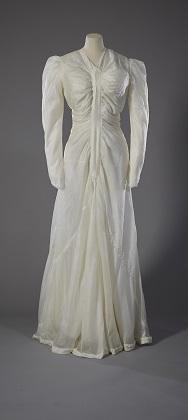In 1943 there were 38,271 marriages in Scotland. This was 9,131 fewer than the previous year and 15,251 fewer than in 1940 – a year which had witnessed an increase in marriages following the outbreak of war in September 1939.
Of the 38,271 marriages, 33,051 were solemnised by a minister of religion, and 5,207 were civil marriages. A further 13 were registered on production of a decree of declarator of the Court of Session.
By 1943 the Second World War was in its fourth year. Rationing had limited the availability of everyday items including petrol, introduced in 1939, food in 1940, and clothing in 1941. The pressure to create an unprecedented quantity of military uniforms led the British government to try to protect the amount of fabric being used for civilian dress, and limit the amount of labour being used to create it. During the war, around a quarter of the British population were required to wear a uniform of some kind as a member of the armed forces, women’s auxiliary forces or one of the uniformed voluntary forces or organisations.
When clothes rationing was first introduced, every adult was given 66 points worth of coupons to last a year. By 1943 this had been reduced to 40 and by 1945 cut to 24. The amount of points a piece of clothing cost was determined by the labour used to produce it, and the amount of material used in its construction. A pair of stockings, for example, cost around 2 coupons, a man’s shirt around 8 and a dress around 11. In addition to a cost in coupons, items of clothing also had a monetary value to be paid.
Whilst fashion became more economical in design, men and women were both still encouraged to take pride in their appearance. For many couples, this was never more important than on their wedding day. Despite a shortage in fabric, many women still wanted to wear a traditional wedding dress. Even Princess Elizabeth, on her marriage to Philip Mountbatten in 1947, conserved her rationing coupons and received a gift of 200 coupons from the British Government to purchase the material required for her gown.
Most brides, however, had to be creative. Some dressed in two-piece outfits or borrowed a family dress. Due to the cost of fabric, a great number of women couldn’t afford the material for a wedding dress. Some women improvised and used parachute silk and later in the war, nylon parachute fabric.
Image

A wedding dress made from parachute silk, 1948
Image featured by kind permission of Hampshire Cultural Trust
Influential women tried to help the cause. Barbara Cartland placed an advertisement in ‘The Lady’ to buy 2 wedding gowns to lend out to brides for the day; over time she collected over 1,000 of them in a bid to add a touch of glamour to a war time wedding. In America, the President’s wife, Eleanor Roosevelt, was instrumental in gathering wedding dresses from American women to create a ‘pool’ of dresses donated for service women’s use.
Twenty-three year old Sheila Davidson, a Driver in the Women’s Auxiliary Air Force (WAAF) wore a borrowed, donated, wedding dress when she married Christopher Bromham, a Corporal in the Royal Air Force Regiment. The couple were married on 16 June 1943 in the Old Parish Church, Melrose. Sheila had decided that she would prefer not to get married in her uniform, an option which some women in service chose.
Image

The wedding entry of Sheila Davidson and Christopher Bromham, 16 June 1943
National Records of Scotland, Statutory Register of Marriages, 1943, 799/1 2
Sheila’s dress had been donated by Mrs George Shaw Green who lived in Dayton, Ohio. She gifted the dress specifically for the use of airwomen who, as the ‘Daily Record’ reported, did ‘not wish to be married in uniform and have no coupons to spare for the customary outfit.’ Sheila was the first woman to wear the dress.
Mrs Shaw Green had donated more than one dress for British brides to use. Six months earlier, on 29 January 1943, the ‘Yorkshire Evening Post’ reported that 19 year old Leading Aircraftwoman Elizabeth Stovell, a WAAF meteorologist, was to marry Aircraftman Cyril Cannell in one of 5 wedding dresses presented to the WAAF by Mrs Shaw Green.
The paper noted that Mrs Shaw Green had ‘sent the gowns because she wanted some of the service women of Britain to have the romance of a white wedding in spite of coupons and clothes economy.’


